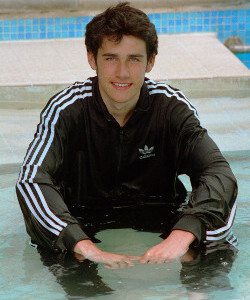Acceptable Training Clothes for Swimming Pools
"Proper swimwear" is normally required, but there isn't really a standard definition for this, otherwise it would be stated. Ask the pool management what their dress code is, especially for lifesaving and survival swimming.
Public pools often have specific clothing rules which you may come up against when you want to do lifesaving training. Ask at the reception if you can wear any training clothes in the pool. Explain that you want to do realistic survival swimming or lifesaving training. Sometimes you have to ask for the pool manager.
- Clothes must be very clean.
- Clothes must only used for pool swimming, not last week's mud run.
- Clothes must be of manmade fibres that don't clog the pool filters with fluff and lint.
The purpose of clothing rules is to minimise the bacterial load by ensuring that nobody can thoughtlessly rinse their dirty clothes in the swimming pool. Otherwise the pool chemicals would have to be monitored and topped up more often, "just to be on the safe side". More chlorine means more stinging eyes and faster rotting swimwear.
Your training venue follows a health and safety policy. Some worry about clogged pool filters while others think their lifeguards may not be able to rescue a fully clothed casualty from the pool. Some pool operators allow you to swim in clothes if you bring an extra set to swim in. This rule tries to maintain a clear distinction between clothes worn in the pool and street clothes worn outside.
Modesty
Recently, dress codes in many pools have been relaxed to allow for additional modesty. Many public swimming pools allow T-shirts in the water, but do not allow other street clothes into the pool, except for survival or lifesaving training.
Clean T-shirts and 3/4 length shorts are alright, depending on the staff on duty.
People probably won't look twice if you choose to wear your T-shirt in a swimming pool.
Just ask and check the pool rules before swimming in clothes.
Proper Fit
Your swimming clothes should fit well, not too tight or too loose. Loose and baggy clothes may get caught on something, particularly on slides. Clothes should be unlined to avoid pockets where water or air gets trapped.
Lifeguard anoraks, tracksuits and other sportswear are best for survival swim training and lifesaving classes. These robust clothes can be used as towing aids.
Clothes must not restrict your movement or cause significant drag in the water, again for safety. The idea that "resistance builds stamina" is evidently considered inappropriate by some safety officers.
Avoid exposed metal rivets or fasteners, because they could cause injury to other swimmers or scratch and damage the slides. Some "approved" Speedo "original swim shorts" have a small metal eyelet at the bottom of the back pocket, where it could easily cause scratches.
If you train outdoors be aware that most sun lotions wash off and leave you exposed to sunburn. Appropriate clothing keeps you covered.
Swim Test
Make sure these clothes fit well before you join any activity. Try them on first in a pool or your bath at home. Swim in your workout clothes before you join any lessons to make sure they fit well and you enjoy swimming in them. Nothing is more annoying than the wrong swimming clothes.
Pool Workout Clothes
If you go to an aquatic gym or lifesaving class for the first time, start in light clothing.
Comfy swimming clothes or sportswear,
like a swim shirt and leggings are best.
Add pool shoes where required.
When you dress up more as you gain confidence, your pulse will go up fast
and make your workout much harder if you want to get really fit.

Start with light swimwear for an easy workout.

As you get stronger wear clothes that soak up more water.

Anoraks and unlined rain pants will push you just a bit more.
Clean Pool Shoes
You'll wear them all the time, even when swimming. Simple shoes with drain holes are best. Socks avoid chafing. You'll be doing a full shoes workout.
Slip-on Swim Fins
Fins are required for some exercises. Get those with a full foot as they fit better. Again, socks may avoid chafing.
Goggles or Mask
You want to be able to see underwater for some of the exercises. Get well fitting goggles or a snorkeling mask for this.
Floatation Belt
A flotation belt (wet belt) around your waist helps you to float upright in deep water while you make walking movements. Clothes worn inside the belt avoid chafing.
Workout Mat (optional)
There will be exercises performed on the pool deck or on the beach.
If you want to be comfortable bring either a mat, poncho or a towel.
Fold it up as needed.
Swim Poncho
You'll also need a poncho or hiking cape for some of the exercises and as warm-up shelter. It is a most useful item to have in your swim bag:
- Sit on it by the pool.
- Useful when changing clothes.
- Comfy as warm-up on poolside or in the pool.
- You can wear it for resistance swim training.
- After your training session you can use it to carry all your wet clothes.
Unlike those bulky swim parkas, it is lightweight, quick drying, and costs a lot less.
Go for the nylon or soft polyester fabric, not the hard and unpleasant PVC.
Equipment
With the right equipment and clothing, you can take advantage of a huge variety of fitness exercises to help build muscle, burn calories, and lose weight, all without putting any unnecessary strain on joints and muscles.
There are many different types of aqua fitness equipment available to meet a variety of goals and needs. Avoid weight cuffs that attach to your legs or ankles.
Water noodles are a popular way to support your balance and assist in maintaining certain positions. Fitness assessories and clothes add extra resistance to help you build muscle.
